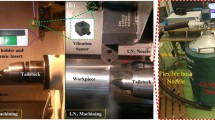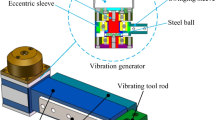Abstract
The 304 austenitic stainless steel is used in a wide range of important industries such as industrial, food, medical, and furniture decoration, seeming the most widely used chromium-nickel stainless steel, but which machinability proves very poor, being a typical difficult cutting material. The tool wear phenomenon is very serious in the process of cutting and is not easy to acquire the splendid machining quality. For this reason, the ultrasonic vibration is introduced into turning to realize ultrasonic vibration-assisted turning (UAT) to solve the above problems in this study. This paper first proves that the ultrasonic vibration has a certain inhibitory effect on the tool wear by theoretical and simulation methods. Then, the influence of technological parameters on the tool wear is studied by experiments. The results show that there is an optimal range of the ultrasonic amplitude and the cutting speed for the UAT, and which has a significant inhibitory effect on the tool wear when the technological parameters are selected properly. The tool wear of conventional turning (CT) is more serious under the same technological parameters. In addition to the abrasive wear and the adhesive wear, the deformation and the collapse also occur, accompanied by obvious sticking substances, which reduce the service life of the cutting tool greatly and has a certain impact on the machining efficiency and the cost. Furthermore, the UAT can also achieve better-machined surface quality under the condition of technological parameters with the less tool wear.

























Similar content being viewed by others
Data availability
All data used in the manuscript are available as submitted.
Code availability
Not applicable.
References
Kumar AS, Durai AR, Sornakumar T (2006) The effect of tool wear on tool life of alumina-based ceramic cutting tools while machining hardened martensitic stainless steel. J Mater Process Technol 173(2):151–156. https://doi.org/10.1016/j.jmatprotec.2005.11.012
Zhang GQ, To S, Zhang SJ (2016) Evaluation for tool flank wear and its influences on surface roughness in ultra-precision raster fly cutting. Int J Mech Sci 118:125–134. https://doi.org/10.1016/j.ijmecsci.2016.09.013
Magalhães LC, Carlesso GC, Lacalle LNL, Souza MT, Palheta FO, Binder C (2022) Tool wear effect on surface integrity in AISI 1045 steel dry turning. Materials 15(6):2031. https://doi.org/10.3390/ma15062031
Xavior MA, Adithan M (2009) Determining the influence of cutting fluids on tool wear and surface roughness during turning of AISI 304 austenitic stainless steel. J Mater Process Technol 209(2):900–909. https://doi.org/10.1016/j.jmatprotec.2008.02.068
Ostasevicius V, Gaidys R, Rimkeviciene J, Dauksevicius R (2010) An approach based on tool mode control for surface roughness reduction in high-frequency vibration cutting. J Sound Vib 329(23):4866–4879. https://doi.org/10.1016/j.jsv.2010.05.028
Abhang L, Hameedullah M (2014) Parametric investigation of turning process on en-31 steel. Procedia Mater Sci 6:1516–1523. https://doi.org/10.1016/j.mspro.2014.07.132
Patil S, Joshi S, Tewari A, Joshi SS (2014) Modelling and simulation of effect of ultrasonic vibrations on machining of Ti6Al4V. Ultrasonics 54(2):694–705. https://doi.org/10.1016/j.ultras.2013.09.010
Xu YS, Wan ZH, Zou P, Huang WL, Zhang GQ (2021) Experimental study on cutting force in ultrasonic vibration-assisted turning of 304 austenitic stainless steel. Proc IMechE Part B: J Eng Manufac 235(3):494–513. https://doi.org/10.1177/0954405420957127
Xiao M, Wang QM, Sato K, Karube S, Soutome T, Xu H (2006) The effect of tool geometry on regenerative instability in ultrasonic vibration cutting. Int J Mach Tools Manuf 46(5):492–499. https://doi.org/10.1016/j.ijmachtools.2005.07.002
Nath C, Rahman M (2008) Effect of machining parameters in ultrasonic vibration cutting. Int J Mach Tools Manuf 48(9):965–974. https://doi.org/10.1016/j.ijmachtools.2008.01.013
Maeng S, Ito H, Kakinuma Y, Min S (2022) Study on cutting force and tool wear in machining of die materials with textured PCD tools under ultrasonic elliptical vibration. Int J Precis Eng Manuf - Green Tech 10(1):35–44. https://doi.org/10.1007/s40684-022-00416-0
Chen ZM, Feng PF, Wang JJ, Feng F, Zha HT (2022) Understanding the abnormal effects of ultrasonic vibration on tool wear and surface generation in Zr-based bulk metallic glass cutting. CIRP J Manuf Sci Technol 39:1–17. https://doi.org/10.1016/j.cirpj.2022.07.004
Huo DH, Cheng K (2019) Vibration assisted machining. Proc IMechE Part C: J Mechanical Eng Sci 233(12):4079–4080. https://doi.org/10.1177/0954406219854227
Xu YS, Gao F, Zou P, Zhang QJ, Fan FL (2020) Theoretical and experimental investigations of surface roughness, surface topography, and chip shape in ultrasonic vibration-assisted turning of Inconel 718. J Mech Sci Technol 34(9):3791–3806. https://doi.org/10.1007/s12206-020-0830-x
Zhou M, Ngoi BKA, Yusoff MN, Wang XJ (2006) Tool wear and surface finish in diamond cutting of optical glass. J Mater Process Technol 174(1-3):29–33. https://doi.org/10.1016/j.jmatprotec.2005.02.248
Zhang YL, Zhou ZM, Wang JL, Li XY (2013) Diamond tool wear in precision turning of titanium alloy. Mater Manuf Process 28(10):1061–1064. https://doi.org/10.1080/10426914.2013.773018
Lotfi M, Amini S, Aghaei M (2018) 3D FEM simulation of tool wear in ultrasonic assisted rotary turning. Ultrasonics 88:106–114. https://doi.org/10.1016/j.ultras.2018.03.013
Lotfi M, Amini S, Aghaei M (2018) Tool wear modeling in rotary turning modified by ultrasonic vibration. Simul Model Pract Th 87:226–238. https://doi.org/10.1016/j.simpat.2018.07.007
Lotfi M, Amini S, Aghaei M (2018) Tool wear prediction and surface improvement in vibration cutting. Tribol T 61(3):414–423. https://doi.org/10.1080/10402004.2017.1339840
Farahnakian M, Keshavarz ME, Elhami S, Razfar MR (2019) Effect of cutting edge modification on the tool flank wear in ultrasonically assisted turning of hardened steel. Proc IMechE Part B: J Eng Manuf 233(5):1472–1482. https://doi.org/10.1177/0954405416640416
Kandi R, Sahoo SK, Sahoo AK (2020) Ultrasonic vibration-assisted turning of Titanium alloy Ti-6Al-4V: numerical and experimental investigations. J Braz Soc Mech Sci Eng 42:399. https://doi.org/10.1007/s40430-020-02481-5
Deswal N, Kant R (2022) Experimental investigation on magnesium AZ31B alloy during ultrasonic vibration assisted turning process. Mater Manuf Process 37(15):1708–1714. https://doi.org/10.1080/10426914.2022.2039701
Goncalves M, Franca TV, Fortulan CA, da Silva RHL, Foschini CR (2022) Green ceramic machining benefits through ultrasonic-assisted turning: an experimental investigation. Int J Adv Manuf Technol 118(9-10):3091–3104. https://doi.org/10.1007/s00170-021-08174-0
Nayak SK, Patro JK, Dewangan S, Gangopadhyay S (2014) Multi-objective optimization of machining parameters during dry turning of AISI 304 austenitic stainless steel using grey relational analysis. Procedia Mater Sci 6:701–708. https://doi.org/10.1016/j.mspro.2014.07.086
Diniz AE, Machado AR, Correa JG (2016) Tool wear mechanisms in the machining of steels and stainless steels. Int J Adv Manuf Technol 87(9-12):3157–3168. https://doi.org/10.1007/s00170-016-8704-3
Correa JG, Schroeter RB, Machado AR (2017) Tool life and wear mechanism analysis of carbide tools used in the machining of martensitic and supermartensitic stainless steels. Tribol Int 105:102–117. https://doi.org/10.1016/j.triboint.2016.09.035
Vivekananda K, Arka GN, Sahoo SK (2014) Finite element analysis and process parameters optimization of ultrasonic vibration assisted turning (UVT). Procedia Mater Sci 6:1906–1914. https://doi.org/10.1016/j.mspro.2014.07.223
Vivekananda K, Arka GN, Sahoo SK (2014) Design and analysis of ultrasonic vibratory tool (UVT) using FEM, and experimental study on ultrasonic vibration-assisted turning (UAT). Procedia Eng 97:1178–1186. https://doi.org/10.1016/j.proeng.2014.12.396
Lotfi M, Amini S (2018) Effect of ultrasonic vibration on frictional behavior of tool-chip interface: Finite element analysis and experimental study. Proc IMechE Part B: J Eng Manuf 232(7):1212–1220. https://doi.org/10.1177/0954408918812271
Lotfi M, Amini S, Ashrafi H (2019) Theoretical and numerical modeling of tool-chip friction in ultrasonic-assisted turning. Proc IMechE Part E: J Proc Mechanical Eng 233(4):824–838. https://doi.org/10.1177/0954408918812271
Usman MM, Zou P, Yang ZY, Lin TY, Muhammad I (2022) Evaluation of micro-textured tool performance in ultrasonic elliptical vibration-assisted turning of 304 stainless steel. Int J Adv Manuf Technol 121(7-8):4403–4418. https://doi.org/10.1007/s00170-022-09539-9
Babitsky VI, Mitrofanov AV, Silberschmidt VV (2004) Ultrasonically assisted turning of aviation materials: simulations and experimental study. Ultrasonics 42(1-9):81–86. https://doi.org/10.1016/j.ultras.2004.02.001
Zou L, Huang Y, Zhou M, Duan L (2017) Investigation on diamond tool wear in ultrasonic vibration-assisted turning die steels. Mater Manuf Process 32(13):1505–1511. https://doi.org/10.1080/10426914.2017.1291958
San HJ, Zhang YX, Chen MF, Wu H (2018) Research on an ultrasonic cutting device based on 0Cr18Ni9. Shock Vib 2018:2515239. https://doi.org/10.1155/2018/2515239
Xu J, Feng PF, Feng F, Zha HT, Liang GQ (2021) Subsurface damage and burr improvements of aramid fiber reinforced plastics by using longitudinal-torsional ultrasonic vibration milling. J Mater Process Technol 297:117265. https://doi.org/10.1016/j.jmatprotec.2021.117265
Yan LT, Zhang XR, Li HY, Zhang QJ (2022) Machinability improvement in three-dimensional (3D) ultrasonic vibration assisted diamond wire sawing of SiC. Ceram Int 48(6):8051–8068. https://doi.org/10.1016/j.ceramint.2021.12.006
Lotfi M, Amini S, Sajjady SA (2019) Development of a friction model based on oblique cutting theory. Int J Mech Sci 160:241–254. https://doi.org/10.1016/j.ijmecsci.2019.06.038
Xu YS, Wan ZH, Zou P, Zhang QJ (2019) Experimental study on chip shape in ultrasonic vibration-assisted turning of 304 austenitic stainless steel. Adv Mech Eng 11(8):1–17. https://doi.org/10.1177/1687814019870896
Shaw MC, Vyas A (1998) The mechanism of chip formation with hard turning steel. CIRP Annals - Manuf Technol 47(1):77–82. https://doi.org/10.1016/S0007-8506(07)62789-9
Kaynak Y, Karaca HE, Noebe RD, Jawahir IS (2013) Tool-wear analysis in cryogenic machining of NiTi shape memory alloys: A comparison of tool-wear performance with dry and MQL machining. Wear 306(1-2):51–63. https://doi.org/10.1016/j.wear.2013.05.011
Funding
This study was supported by Jiangxi Provincial Natural Science Foundation, China (Nos. 20212BAB204001 and 20202BAB204021); the Science and Technology Research Project of Jiangxi Provincial Education Department, China (No. GJJ2200724); the National Natural Science Foundation of China (No. 52065003); and the Experimental Technology Research and Development Project of East China University of Technology (No. DHSY-202211).
Author information
Authors and Affiliations
Corresponding authors
Ethics declarations
Ethical approval
Not applicable.
Consent to participate
Not applicable.
Consent for publication
Not applicable.
Conflict of interest
The authors declare no competing interests.
Additional information
Publisher’s note
Springer Nature remains neutral with regard to jurisdictional claims in published maps and institutional affiliations.
Rights and permissions
Springer Nature or its licensor (e.g. a society or other partner) holds exclusive rights to this article under a publishing agreement with the author(s) or other rightsholder(s); author self-archiving of the accepted manuscript version of this article is solely governed by the terms of such publishing agreement and applicable law.
About this article
Cite this article
Xu, Y., Zhang, J., Zhang, Q. et al. Theoretical and experimental investigations of tool wear in ultrasonic vibration–assisted turning of 304 austenitic stainless steel. Int J Adv Manuf Technol 127, 3157–3181 (2023). https://doi.org/10.1007/s00170-023-11686-6
Received:
Accepted:
Published:
Issue Date:
DOI: https://doi.org/10.1007/s00170-023-11686-6




